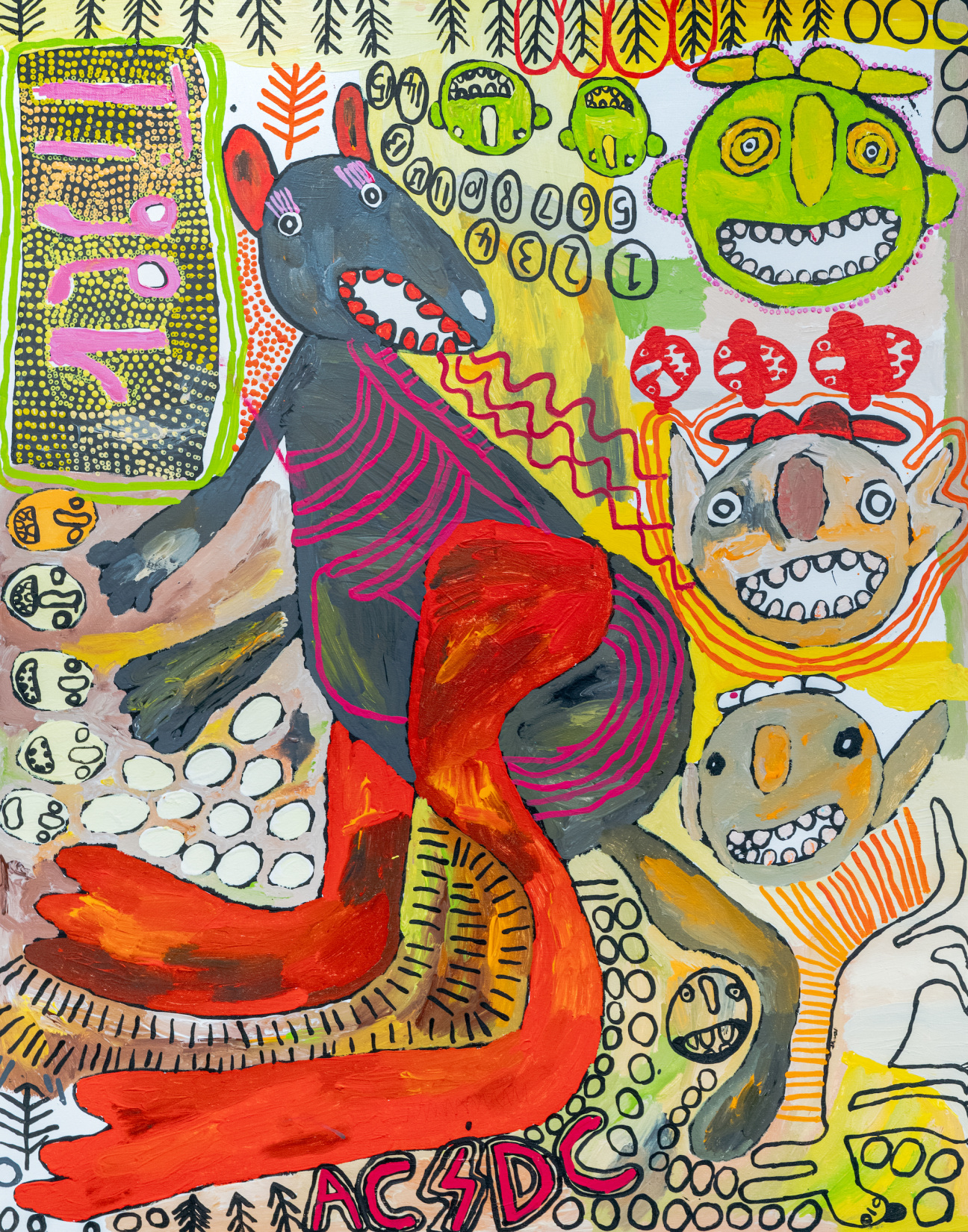In recent years, the massive critical reappraisal of Australian Aboriginal art, a rich and radically singular tradition of mark making that’s history spans thousands of years into the pre-colonial past, has returned the vigorous spontaneity of a gestural language composed of swirling dashes and dots to the collective mind of the contemporary art world. Undeniably, this outburst of renewed interest and attention owes something to our persistent fascination in the West with the aesthetic achievements of 20th-century modernism, perhaps chief among them Abstract Expressionism and process art. The immediate visual similarity between the works of now thoroughly canonized legends of the last century’s aesthetic avant-gardes like Jackson Pollock or Yayoi Kusama on the one hand, and the pulsating cosmic spirals that blossom on cave walls, tree bark, clothing, and musical instruments throughout the Australian continent on the other, threatens to contaminate our understanding of the unique artistic propositions made by Aboriginal painting. A new generation of Indigenous artists whose exuberantly political work, saturated with personality and wit, befuddles the modernist mythos of purity and isolation that dominates so many conversations about Aboriginal abstraction.

In New York gallery Fort Gansevoort’s refreshingly human “Iwantja Rock n Roll”—an exhibition on view through August 20 featuring paintings by Vincent Namatjira, Kaylene Whiskey, and Tiger Yaltangki—the multi-generational trio of Aboriginal image makers' take on the symbolic authority of empire, metabolizing cultural icons as thoroughly and synonymously American as the Statue of Liberty, Wonder Woman, the Route 66 highway marker, and the electric guitar, as well as authority’s ultimate figurehead herself: Queen Elizabeth, in expressive flurries of brightly hued acrylic. Albert Namatjira, Vincent Namatjira’s grandfather, is a masterful watercolorist whose John Singer Sargent-like renderings of the landscapes of the Australian outback, or “Country” as many Aboriginal artists still refer to it, prove “that this place—the mountains, the trees—is a part of us,” his grandson says. For Vincent, who only learned of Albert’s work as an adult after growing up for most of his life in foster care, these poetic pictures of his environment confirmed something even deeper: that painting is in his “blood.”

One of the exhibition’s many masterpieces is a series of paintings depicting the younger Namatjira greeting various members of the British royal family as the imposing mountains that govern the Anangu Pitjantjatjara Yankunytiga lands where Vincent now works sit flatly indifferent behind them. It is directly inspired by a photograph Vincent discovered of his preeminent artist grandfather meeting the Queen on a trip to Australia decades before his own birth. Tonally, the work eschews direct critique, like both Whiskey and Yaltangki, Namatjira’s playful flirtation with the cultural products of their colonizers enlivens our understanding of their political conditions. It speaks truth to the utter absurdity of their history, which were it not devastatingly horrific might just be hilarious. In the painting, Vincent sitting opposite the decaying monarch with a very regal looking dog perched between them, dons an AC/DC band shirt. The influence of music courses throughout the show like a thundering baseline. In Whiskey’s highly stylized psychedelic compositions that she describes as bringing “the comic to the canvas” for example, female popstars are adorned with the region’s traditional dot-paintings, a technique Whiskey learned too from her “grandfather, mother, and aunties.” Yaltangki’s paintings too combine mythological characters from the spiritual world of the Anagu with our own contemporary deities from the magical universes of rock n’ roll and science fiction. Irreverence here is its own form of rebellion.

The exhibition’s title refers to the Iwantja Arts Community, an Indigenous art center in Indulkana that for the past 40 years has nurtured the work of Aboriginal artists. The show represents the group’s first exhibition in New York, or as Namatjira calls it, “The big smoke!” And while Whiskey, Yaltangki, and Namatjira have all enjoyed significant attention on their own both in Australia and increasingly on the world stage, perhaps what sets them apart is how much they support each other and how directly their work engages with community, be it their immediate surroundings in the remote desert lands of North West Australia or the pantheon of pop culture. What their paintings make gloriously visible is what crucially sets Aboriginal art apart from the work of the alienated New York school of Abstract Expressionists with which is shares visual similarities: a vibrant social world bustling with the beautifully mundanity of daily life that, for them, art brings together into a single web of collective experience.










 in your life?
in your life?

